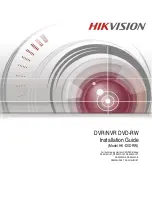
E6581381
M-7
13
13.4 How to determine the causes of other problems
The following table provides a listing of other problems, their possible causes and remedies.
Problems
Causes and remedies
The motor runs in the
wrong direction.
•
Invert the phases of the output terminals U, V and W.
•
Invert the forward/reverse run-signal terminals of the external input device.
⇒
See section 6.3 "Assignment of functions to control terminals".
•
Change the setting of the parameter
HT
in the case of panel operation.
The motor runs but its
speed does not change
normally.
•
The load is too heavy. Reduce the load.
•
The soft stall function is activated. Disable the soft stall function.
⇒
See section 5.12.
•
The maximum frequency
HJ
and the upper limit frequency
WN
are set too low.
Increase the maximum frequency
HJ
and the upper limit frequency
WN
.
•
The frequency setting signal is too low. Check the signal set value, circuit, cables, etc.
•
Check the setting characteristics (point 1 and point 2 settings) of the frequency setting
signal parameters.
⇒
See section 6.5.
•
If the motor runs at a low speed, check to see that the stall prevention function is
activated because the torque boost amount is too large.
Adjust the torque boost amount (
XD
) and the acceleration time (
CEE
).
⇒
See section 5.11 and 5.1.
The motor does not
ac-celerate or decelerate
smoothly.
•
The acceleration time (
CEE
) or the deceleration time (
FGE
) is set too short.
Increase the acceleration time (
CEE
) or the deceleration time (
FGE
).
A too large current flows
into the motor.
•
The load is too heavy. Reduce the load.
•
If the motor runs at a low speed, check whether the torque boost amount is too large.
⇒
⇒
See section 5.11.
The motor runs at a higher
or lower speed than the
specified one.
•
The motor has an improper voltage rating. Use a motor with a proper voltage rating.
•
The motor terminal voltage is too low.
Check the setting of the base frequency voltage parameter (
XNX
) .
⇒
See section 6.12.5.
Replace the cable with a cable larger in diameter.
•
The reduction gear ratio, etc., are not set properly. Adjust the reduction gear ratio, etc.
•
The output frequency is not set correctly. Check the output frequency range.
•
Adjust the base frequency.
⇒
See section 5.9.
The motor speed fluctu-ates
during operation.
•
The load is too heavy or too light. Reduce the load fluctuation.
•
T
he inverter or motor used does not have a rating large enough to drive the load.
Use an inverter or motor with a rating large enough.
•
Check whether the frequency setting signal changes.
•
If the V/F control selection parameter
RV
is set at
, check the vector control setting,
operation conditions, etc.
⇒
See section 5.10.
Parameter settings cannot
be changed.
Change the setting of the parameter
H
(prohibition of change of parameter
setting) to
(permitted) if it is set at
(prohibited).
* For reasons of safety, some parameters cannot be reprogrammed while the inverter is
running.
⇒
See section 4.2.6.
How to cope with parameter setting-related problems
If you forget parameters
which have been reset
•
You can search for all reset parameters and change their settings.
⇒
See section 4.2.3 for details.
If you want to return all
reset parameters to their
respective default settings
•
You can return all parameters which have been reset to their default settings.
⇒
See section 4.2.7 for details.
Summary of Contents for TOSVERT VF-FS1 Series
Page 2: ......
Page 15: ...E6581381 A 3 1 1 3 Names and functions 1 3 1 Outside view Operation panel ...
Page 18: ...E6581381 A 6 1 VFFS1 2004 2037PM VFFS1 4004 4055PL Note EMC plate is supplied as standard ...
Page 36: ......
Page 40: ...E6581381 B 4 2 2 2 2 Standard connection diagram 2 ...
Page 54: ......
Page 56: ...E6581381 D 2 4 4 1 Flow of status monitor mode Flow of monitor as following ...
Page 66: ......
Page 180: ......
Page 196: ......
Page 208: ......
Page 233: ...E6581381 L 5 12 Outline drawing Fig A Fig B Fig C Fig D ...
Page 242: ......
Page 248: ......
Page 251: ......












































